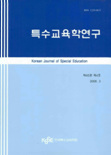- 영문명
- A Study on Playfulness of Autistic Children - Based on Test of Playfulness (ToP) -
- 발행기관
- 한국특수교육학회
- 저자명
- 진흥신(Jin Heungshin) 이상진(Lee Sang Jin)
- 간행물 정보
- 『특수교육학연구』제42권 제1호, 165~186쪽, 전체 22쪽
- 주제분류
- 사회과학 > 교육학
- 파일형태
- 발행일자
- 2007.06.30

국문 초록
본 연구의 목적은 자폐아동의 놀이다움 특성을 밝히기 위해 놀이다움 요소별 특성 즉 동기근원, 통제지각, 현실감 부재, 참조체계특성을 밝히고자 하였다. 본 연구에 참여한 아동은 총 52명으로 일반발달아동 26명(남 19명, 여 7명)과 자폐아동 26명(남 19명, 여 7명)이다. 본 연구에 적용한 연구도구는 Bundy(2003)가 제작한 놀이다움 평정척도 4.0을 진흥신(2003)이 우리나라 일반발달아동과 장애아동을 대상으로 예비표준화한 한국판 놀이다움 평정척도이다. 자료처리는 놀이다움 평정척도에서 얻어진 원점수를 Rasch 분석하였고, 자폐아동과 일반발달아동이 반응한 문항반응 측정치 비교를 통하여 동기근원, 통제지각, 현실감부재, 참조체계의 특성을 밝혔다. 본 연구를 통해 발견된 자폐아동의 놀이다움 요소별 특성은 다음과 같다. 첫째, 자폐아동의 동기근원은 내적 동기 성향을 보이는 문항과 외적 동기성향을 보이는 문항이 확실하게 구분되었다. 즉 자폐아동의 동기근원은 내적 동기 성향과 외적 동기성향이 동시에 보였지만, 더 많은 문항에서 내적 동기 성향을 보였다. 둘째, 자폐아동의 독자적 통제지각은 동기근원과 마찬가지로 내적 통제성향과 외적 통제 성향이 동시에 보였지만, 더 많은 문항에서 내적 통제 성향을 보였다. 공유적 통제지각은 외적 통제 성향을 보였다. 셋째, 자폐아동의 현실감부재 특성은 모든 문항에서 부자유한 현실감 부재를 보였다. 넷째, 자폐아동의 참조체계 특성은 부자유하게 사회적 단서를 주고받았다. 그러므로 자폐아동의 놀이다움에 대한 미래연구는 자폐아동의 내적 동기 성향과 독자적 내적 통제 성향에 기초하여 비놀이다움을 놀이다움으로 전환시킬 수 있는 놀이 중재 프로그램 개발이 요청된다.
영문 초록
The purpose of this study was to find out the characteristics of playfulness of autistic children: source of motivation, perception of control, suspension of reality, framing. The subjects were 26 children without disabilities (19 boys and 7 girls) and 26 autistic children (19 boys and 7 girls). Korean Test of Playfulness (version 4.0) was the measurement inventory in this study, which was originally developed by Bundy (2003) and standardized by Heung-shin Jin(2003) in order to measure the playfulness of both children with autism and without disabilities. The raw data of the test were analyzed by Rasch Analysis. As the results of this research, autistic children showed internal motivation; internal tendency in self control perception, external tendency in shared control perception; lack of freedom in suspension of reality; and restricted framing. This means autistic children has tendency of nonplayfulness whereas the children without disabilities are generally playful. In conclusion, it is suggested that internal-motivation-oriented educational activities should be developed for autistic children, as an intervention which converts nonplayfulness to playfulness.
목차
〈요약〉
Ⅰ. 서론
Ⅱ. 이론적 배경
Ⅲ. 연구방법
Ⅳ. 연구결과
Ⅴ. 논의 및 결론
참고문헌
Abstract
Ⅰ. 서론
Ⅱ. 이론적 배경
Ⅲ. 연구방법
Ⅳ. 연구결과
Ⅴ. 논의 및 결론
참고문헌
Abstract
키워드
해당간행물 수록 논문
참고문헌
최근 이용한 논문
교보eBook 첫 방문을 환영 합니다!

신규가입 혜택 지급이 완료 되었습니다.
바로 사용 가능한 교보e캐시 1,000원 (유효기간 7일)
지금 바로 교보eBook의 다양한 콘텐츠를 이용해 보세요!


